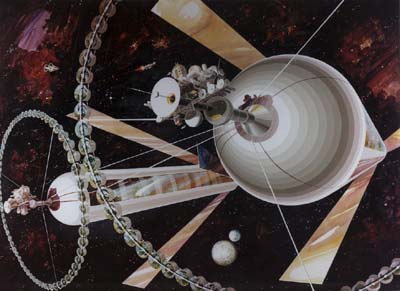What future for intelligent life in space?
by Stephen Ashworth
Thirty-five years ago, Gerard K. O’Neill wrote: “We are so used to living on a planetary surface that it is a wrench for us even to consider continuing our normal human activities in another location” (The High Frontier, p.25). He concluded that the best place for a growing industrial society is not on the Earth, or the Moon or Mars, but “somewhere else entirely”: an array of artificially constructed space colonies.
While a planet is a good place for life to get started, once it has reached the stage of industrial development, its further growth depends on the use of technology to construct artificial space colonies.
Judging from current attitudes, his fundamental insight is still enough of “a wrench” that it has yet to gain wide acceptance. For example, the material published so far by the DARPA-NASA Ames 100-Year Starship Study ignores colonies in space, despite their obvious relevance, as does Lou Friedman’s report on their recent meeting (see “Fly me to the stars”, The Space Review, January 24, 2011). Joy Shaffer’s 2004 essay“Better Dreams” at Spacedaily.com, enthusiastically referenced by one Space Review commenter, explicitly excludes colonies in space: “there is no need to massively industrialize any place in the solar system beyond the elevator terminals and power stations at geosynchronous orbit”. Even the Tau Zero Foundation focuses on “the ultimate goal of reaching other habitable worlds”.




No comments:
Post a Comment